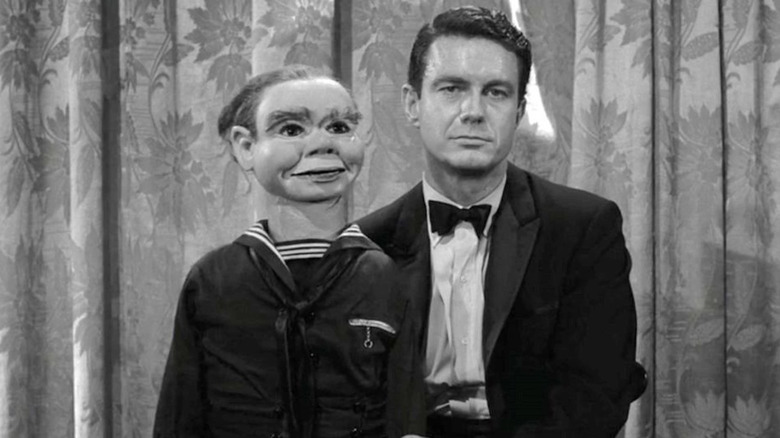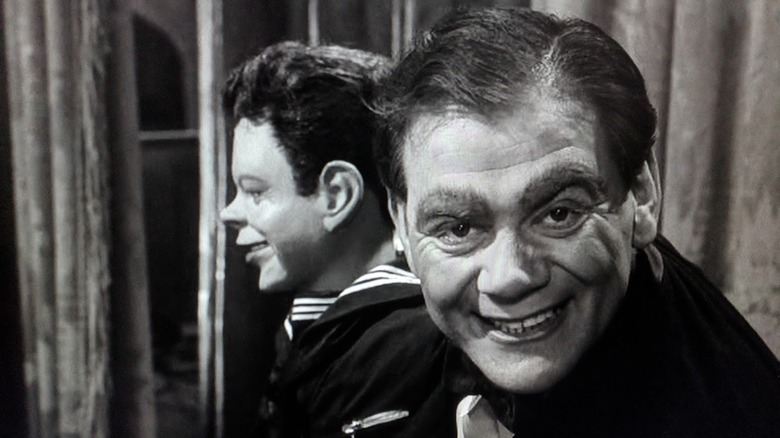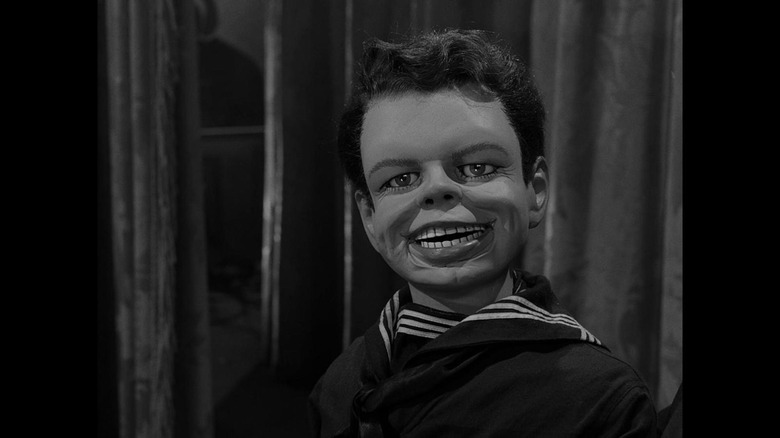The Twilight Zone Needed A Favor From A Disney Great To Make The Dummy Work
One thing you can always count on from horror anthology shows is that eventually, they'll get to an episode about ventriloquist dolls. Don Rickles starred in an episode of "Tales from the Crypt" about a ventriloquist and his dummy and the granddaddy of them all, "The Twilight Zone," had multiple episodes centered around a ventriloquist and his little wooden pal.
And why wouldn't they? Ventriloquist dummies exist on that same uncanny valley plane as overly realistic porcelain dolls that everybody's grandmother collected for some reason. They're just creepy.
For episode 98, titled "The Dummy," the storytellers wanted to convey a tale about a down-and-out ventriloquist convinced his puppet is alive and being uncooperative. Of course, to the outside world it looks like the dude is having a mental break, but in true "Twilight Zone" fashion the big twist is that the main character's doll is indeed alive. The shocking reveal goes one step further because, at the very end, we see the man and doll have somehow switched places with the dummy being a flesh and blood human and the ventriloquist has been transformed into a doll.
Walt Disney Animation comes to the rescue
The episode starred Cliff Robertson (who most modern cinema fans will recognize as Tobey Maguire's Uncle Ben in the Sam Raimi "Spider-Man" movies) and if they were going to sell the nightmare-inducing final reveal that the ventriloquist dummy had swapped places with the handsome star, then they were going to need to make the human look like Willy the Puppet and the puppet look somewhat like Cliff Robertson.
Rod Serling and his crew didn't have anyone on staff that could handle that, so they ended up recruiting for an unlikely source: Walt Disney Animation.
As the story goes (at least according to 1992's "The Twilight Zone Companion" written by Marc Scott Zicree), "Twilight Zone" makeup effects artist, William Tuttle was hard up for ways to pull off the effect in a way that would please Serling, who was determined that the gag only works if the audience can recognize Robertson in the dummy at the end. It still had to look like a real ventriloquist's dummy, but have enough of the actor's features so nobody walked away from the episode confused.
Tuttle had the mechanics of the prop covered but needed someone talented in caricature to design the face. One short consult with "Twilight Zone" production manager Ralph Nelson resulted in the name T. Hee.
It's A Creepy World After All
Thornton Francis Hee was a well-known and well-respected character designer who was responsible for celebrity caricatures in 1936's "The Coo Coo Grove" and 1937's "The Woods Are Full of Cuckoos." He was hired by Disney and leant his artistic talents to everything from "Pinocchio" and "Fantasia" to designing titles for "The Parent Trap" and "The Shaggy Dog."
He preferred to go by T. Hee (a pretty funny play on words, I must admit) and was always credited as such in his work.
T. Hee was contacted by the "Twilight Zone" team and was more than happy to provide some caricature drawings of Cliff Robertson so the effects team could whip up a ventriloquist dummy that sold the big twist of the episode.
If you've ever ridden "It's A Small World" at any of the Disney parks, you know that creepy dolls and Disney go way back, but it's still funny to me to picture "The Twilight Zone" production company calling up Walt Disney Animation to look for help in pulling off a creepy doll for their show.
A little bit of trivia before we wrap up: the final Cliff Robertson doll used in the episode is now one part of magician David Copperfield's collection. The dummy is on display in The International Museum and Library of the Conjuring Arts in Las Vegas, along with the Willy puppet used in this very same episode.


